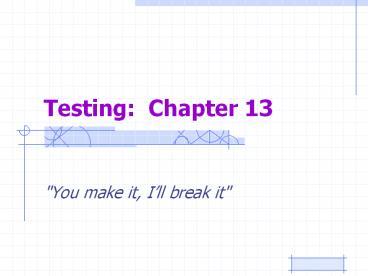Testing: Chapter 13 PowerPoint PPT Presentation
1 / 23
Title: Testing: Chapter 13
1
Testing Chapter 13
- "You make it, Ill break it"
2
Purpose
- Does the product as a whole perform up to
specifications? (validation?) - Does it perform under normal, upper, and lower
limits wrt the environment? - Does it meet or exceed all claims (verification)?
3
Testing defined
- establishing confidence that a device does what
it is supposed to do - the process of operating a device with the intent
of finding errors - detecting specification errors and deviations
from the specification
4
Testing continued
- verifying that a system satisfies its specified
requirements or identifying differences between
expected and actual results - the process of operating a device or component
under specified conditions, observing or
recording the results, and making an evaluation
of some aspect of the system or component.
5
Testing
- Is a positive act of destruction.
- Is needed for good product development
- Is necessary for consumer satisfaction
6
Stressors (depend on requirements)
Temperature Humidity
Altitude Shock
Vibration EMI
Cell phone, pagers Brownouts
ESD Spillage
Shipping Power Surges
7
Figure 13-1 Requirements checklist
8
Customer Misuse
- Coffee spillage
- Drop in toilet
- Use as a seat
- Cross-connecting
- Reverse polarity
- Dirty hands
- Unplugging via jerk on cable
9
Testing requires that you define failure!
- Intended application?
- Anticipated environment?
- Lifetime?
- Value vs. time
- Sunken ships make good coral reefs in time
10
Types of testing
- Event testing cycling, time to failure
- Environmental operating storage
- Altitude
- Threshold (door, elevator, bricks )
- Vibration
- ISTA shipping test
- EMI (standards!, see next slide )
11
EN 1000 series standards
- Radiated electric field immunity
- Fast transients
- Surge, line, magnetic
- Dips, variations, V, F variation
- On/off, ESU
- Walkie-talkie, cell phone
- ESU, etc.
12
Failure Definition
- For each test and for each device, a failure
must be defined. This definition depends on the
intended application and the anticipated
environment. What is considered a failure for
one component or device may not be a failure for
another. The test protocol should be as detailed
as possible in defining the failure.
13
We want to test some power supplies to prove a
MTBF goal of 50,000 hours of operation. How many
units do we test and for how long, assuming one
failure and 90 confidence level?
(sample size)(test time) MTBF goal
(7.779)/2 (sample size)(test time) 50,000
(7.779)/2 194,475
unit-hours
14
Determining Sample Size and Test Length
MTBF goal (sample size)(test time) (2)/?2
a2r2
Confidence level 1 - a, where a is the risk
factor and r the number of failures
Example---------------------------
Using the 90 confidence level, a 0.10 no
failures (r0)
(Sample size)(test time) (MTBF goal)( ?2 a2
)/2
(sample size)(test time) MTBF goal (4.61)/2
to prove a MTBF goal of 50,000 hours of operation
(sample size)(test time) 50,000 (4.61)/2
115,250 unit-hours
15
Types of Testing Verification
- Procedures that attempt to determine that the
product of each phase of the development process
is an implementation of a previous phase, i.e.,
it satisfies it. Each verification activity is a
phase of the testing life cycle
16
Types of Testing Validation
- Validation is the process of evaluating a system
or component during or at the end of the
development process to determine whether it
satisfies specified requirements
17
Types of Testing Black Box
- Black box testing is a data driven testing
scheme. The tester views the device or program
as a black box, i.e., the tester is not concerned
about the internal behavior and structure. The
tester is only interested in finding
circumstances in which the device or program does
not behave according to its specification
18
Types of Testing White Box
- White box testing is concerned with the degree
to which test cases exercise or cover the
structure of the device or program. The ultimate
while box test is an exhaustive path test.
19
Types of testing Software
- Module
- Integration
- System
- Acceptance
20
Types of testingFuctional
- This type of testing verifies that given all the
expected inputs then all of the expected outputs
are produced. This type of testing is termed
success oriented testing because the tests are
expected to produce successful results.
21
Types of testing - continued
- Robustness Testing
- Stress Testing
- Safety testing
- Regression Testing
22
Types of testing, continued
- Life test/reliability
- Customer misuse
- Fluid spillage
- Weight test
- Keyed connections
- Time related
- Failure related (MTBF)
23
Questions?

